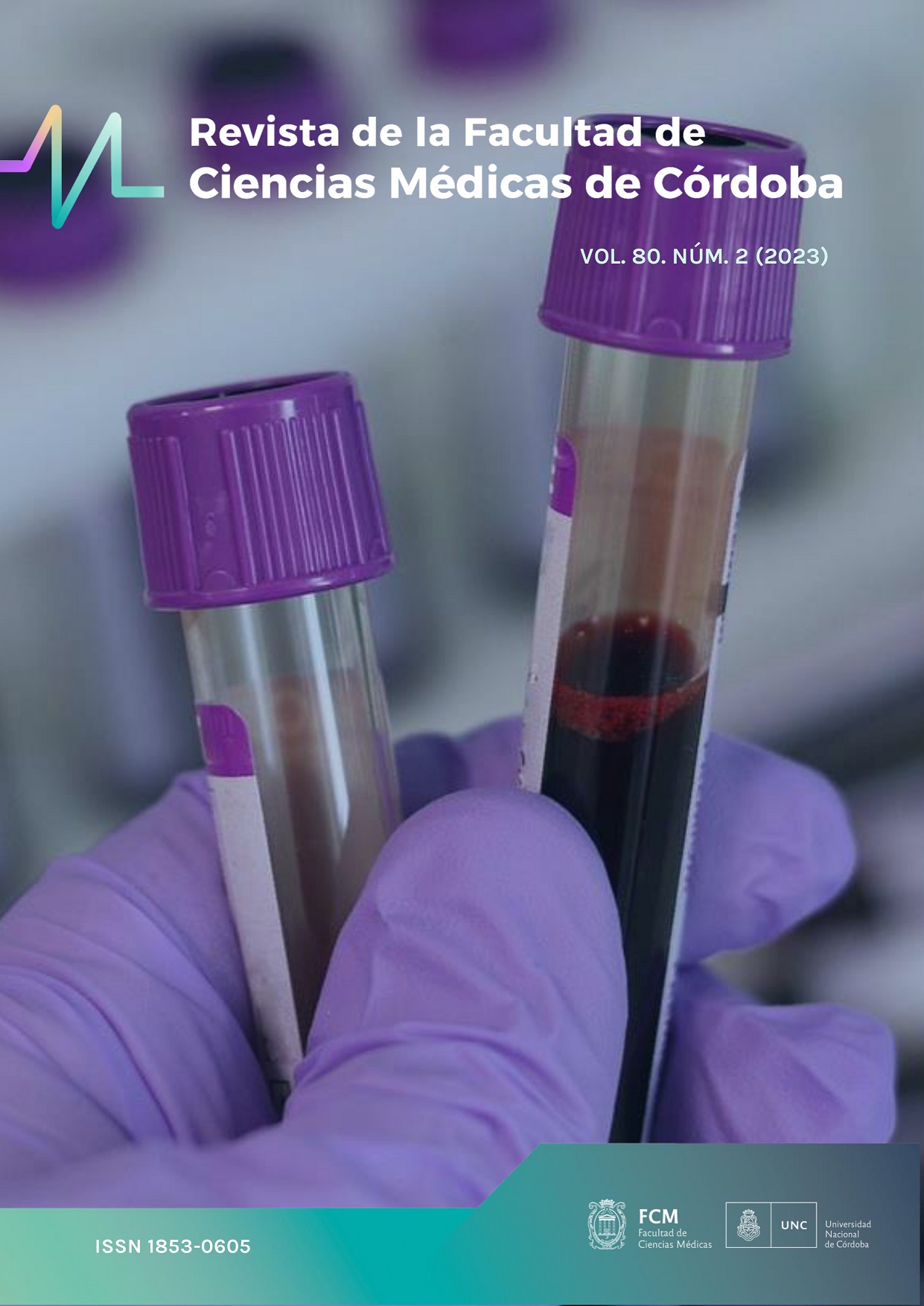Evaluación de fenotipos nutricionales del recién nacido con el estándar INTERGROWTH-21st para predicción de morbilidad y mortalidad neonatales
DOI:
https://doi.org/10.31053/1853.0605.v77.n2.28064Palabras clave:
trastornos nutricionales en el feto, estatura por edad, índice de masa corporal, morbilidad, mortalidad infantilResumen
Introducción: El uso de referencias locales o estándares para estudios neonatales aún requiere su validación a través de indicadores de morbilidad y mortalidad. Objetivo: Comparar la capacidad predictiva del estándar INTERGROWTH-21st (IG-21st) y una referencia argentina (Urquia) mediante los fenotipos de crecimiento fetal y morbi-mortalidad neonatales.
Métodos: Estudio de cohorte retrospectivo de recién nacidos vivos entre 33 y 42 semanas del Hospital Materno-Infantil Ramón Sarda (Buenos Aires, Argentina), entre 1996-2001 (n = 25948). Los fenotipos pequeños (PEG) y grandes para la edad gestacional, acortado y emaciado y un índice compuesto de morbilidad / mortalidad neonatal (CNMM) se contrastaron entre IG-21st y la referencia Urquia.
Resultados: El 3er percentil del peso al nacer de Urquia fue menor que el de IG-21st antes de las 37 semanas; 2.3%, 5.9% y 8.9 de los RN fueron <3o, <10° y > 97° percentil, respectivamente, bajo el estándar IG-21st, mientras que 3,7%, 10,1% y 8,4% fueron <3 °, <10 ° y> 97 ° percentil, respectivamente, bajo la referencia Urquia. Acortados fueron 16.1% y emaciados 0.9%, bajo IG-21st. CNMM bajo IG-21st fueron 28.5%, 19.6% y 8.5% en peso<3o, <10º y >97º percentil, respectivamente, mientras que 21.8%, 14.2% y 8.0% ocurrieron en peso< 3°, <10° y > 97° percentil bajo Urquia. Acortados fueron 17.3% y emaciados 18.3%. Los RN <3er°, <10° y > 97° percentil bajo IG-21st mostraron mayor riesgo de CNMM en comparación con la referencia Urquia.
Conclusiones: El estándar IG-21st identificó mayor riesgo de morbilidad y mortalidad que la referencia Urquia.
Descargas
Citas
Urquia ML. Variability in birthweight, birthweight charts, and adverse outcomes: Is the "right size" the right question? Paediatr Perinat Epidemiol. 2019 Nov;33(6):433-435. doi: 10.1111/ppe.12608.
Liu S, Metcalfe A, León JA, Sauve R, Kramer MS, Joseph KS; Canadian Perinatal Surveillance System (Public Health Agency of Canada). Evaluation of the INTERGROWTH-21st project newborn standard for use in Canada. PLoS One. 2017 Mar 3;12(3):e0172910. doi: 10.1371/journal.pone.0172910.
Villar J, Cheikh Ismail L, Victora CG, Ohuma EO, Bertino E, Altman DG, Lambert A, Papageorghiou AT, Carvalho M, Jaffer YA, Gravett MG, Purwar M, Frederick IO, Noble AJ, Pang R, Barros FC, Chumlea C, Bhutta ZA, Kennedy SH; International Fetal and Newborn Growth Consortium for the 21st Century (INTERGROWTH-21st). International standards for newborn weight, length, and head circumference by gestational age and sex: the Newborn Cross-Sectional Study of the INTERGROWTH-21st Project. Lancet. 2014 Sep 6;384(9946):857-68. doi: 10.1016/S0140-6736(14)60932-6.
Victora CG, Villar J, Barros FC, Ismail LC, Chumlea C, Papageorghiou AT, Bertino E, Ohuma EO, Lambert A, Carvalho M, Jaffer YA, Altman DG, Noble JA, Gravett MG, Purwar M, Frederick IO, Pang R, Bhutta ZA, Kennedy SH; International Fetal and Newborn Growth Consortium for the 21st Century (INTERGROWTH-21st). Anthropometric Characterization of Impaired Fetal Growth: Risk Factors for and Prognosis of Newborns With Stunting or Wasting. JAMA Pediatr. 2015 Jul;169(7):e151431. doi: 10.1001/jamapediatrics.2015.1431.
Alexander GR, Himes JH, Kaufman RB, Mor J, Kogan M. A United States national reference for fetal growth. Obstet Gynecol. 1996 Feb;87(2):163-8. doi: 10.1016/0029-7844(95)00386-X.
Verburg BO, Steegers EA, De Ridder M, Snijders RJ, Smith E, Hofman A, Moll HA, Jaddoe VW, Witteman JC. New charts for ultrasound dating of pregnancy and assessment of fetal growth: longitudinal data from a population-based cohort study. Ultrasound Obstet Gynecol. 2008 Apr;31(4):388-96. doi: 10.1002/uog.5225.
Urquia ML, Alazraqui M, Spinelli HG, Frank JW. Referencias poblacionales argentinas de peso al nacer según multiplicidad del parto, sexo y edad gestacional [Reference birthweights for the Argentine population by multiplicity of birth, sex, and gestational age]. Rev Panam Salud Publica. 2011 Feb;29(2):108-19.
Darlow BA, Horwood LJ, Wynn-Williams MB, Mogridge N, Austin NC. Admissions of all gestations to a regional neonatal unit versus controls: 2-year outcome. J Paediatr Child Health. 2009 Apr;45(4):187-93. doi: 10.1111/j.1440-1754.2008.01457.x.
Wells JCK, Briend A, Boyd EM, Berkely JA, Hall A, Isanaka S, Webb P, Khara T, Dolan C. Beyond wasted and stunted-a major shift to fight child undernutrition. Lancet Child Adolesc Health. 2019 Nov;3(11):831-834. doi: 10.1016/S2352-4642(19)30244-5.
Janes H, Pepe MS, Gu W. Assessing the value of risk predictions by using risk stratification tables. Ann Intern Med. 2008 Nov 18;149(10):751-60. doi: 10.7326/0003-4819-149-10-200811180-00009.
International guidelines for ethical review of epidemiological studies. In: Brankowski Z, Bryan J, (eds.) Ethics and Epidemiology: International Guidelines. Geneva: CIOMS; 1991.
Youden WJ. Index for rating diagnostic tests. Cancer. 1950 Jan;3(1):32-5. doi: 10.1002/1097-0142(1950)3:1<32::aid-cncr2820030106>3.0.co;2-3.
Groom KM, Poppe KK, North RA, McCowan LM. Small-for-gestational-age infants classified by customized or population birthweight centiles: impact of gestational age at delivery. Am J Obstet Gynecol. 2007 Sep;197(3):239.e1-5. doi: 10.1016/j.ajog.2007.06.038.
Gardosi J, Clausson B, Francis A. The value of customised centiles in assessing perinatal mortality risk associated with parity and maternal size. BJOG. 2009 Sep;116(10):1356-63. doi: 10.1111/j.1471-0528.2009.02245.x.
Kozuki N, Katz J, Christian P, Lee AC, Liu L, Silveira MF, Barros F, Tielsch JM, Schmiegelow C, Sania A, Roberfroid D, Ndyomugyenyi R, Mullany LC, Mongkolchati A, Huybregts L, Humphrey J, Fawzi W, Baqui AH, Adair L, Oddo VM, Black RE; Child Health Epidemiology Reference Group Preterm Birth–SGA Working Group. Comparison of US Birth Weight References and the International Fetal and Newborn Growth Consortium for the 21st Century Standard. JAMA Pediatr. 2015 Jul;169(7):e151438. doi: 10.1001/jamapediatrics.2015.1438.
Revollo GB, Martínez JI, Grandi C, Alfaro EL, Dipierri JE. Prevalence of underweight and small for gestational age in Argentina: Comparison between the INTERGROWTH-21st standard and an Argentine reference. Arch Argent Pediatr. 2017 Dec 1;115(6):547-555. doi: 10.5546/aap.2017.eng.547.
Park FJ, de Vries B, Hyett JA, Gordon A. Epidemic of large babies highlighted by use of INTERGROWTH21st international standard. Aust N Z J Obstet Gynaecol. 2018 Oct;58(5):506-513. doi: 10.1111/ajo.12748.
Unterscheider J, Daly S, Geary MP, Kennelly MM, McAuliffe FM, O'Donoghue K, Hunter A, Morrison JJ, Burke G, Dicker P, Tully EC, Malone FD. Optimizing the definition of intrauterine growth restriction: the multicenter prospective PORTO Study. Am J Obstet Gynecol. 2013 Apr;208(4):290.e1-6. doi: 10.1016/j.ajog.2013.02.007.
Reddy KV, Sharma D, Vardhelli V, Bashir T, Deshbotla SK, Murki S. Comparison of Fenton 2013 growth curves and Intergrowth-21 growth standards to assess the incidence of intrauterine growth restriction and extrauterine growth restriction in preterm neonates ≤32 weeks. J Matern Fetal Neonatal Med. 2019 Oct 27:1-8. doi: 10.1080/14767058.2019.1670795.
Khara T, Mwangome M, Ngari M, Dolan C. Children concurrently wasted and stunted: A meta-analysis of prevalence data of children 6-59 months from 84 countries. Matern Child Nutr. 2018 Apr;14(2):e12516. doi: 10.1111/mcn.12516.
Mikolajczyk RT, Zhang J, Betran AP, Souza JP, Mori R, Gülmezoglu AM, Merialdi M. A global reference for fetal-weight and birthweight percentiles. Lancet. 2011 May 28;377(9780):1855-61. doi: 10.1016/S0140-6736(11)60364-4.
Kramer MS. Socioeconomic determinants of intrauterine growth retardation. Eur J Clin Nutr. 1998 Jan;52 Suppl 1:S29-32; discussion S32-3.
Zhang X, Platt RW, Cnattingius S, Joseph KS, Kramer MS. The use of customised versus population-based birthweight standards in predicting perinatal mortality. BJOG. 2007 Apr;114(4):474-7. doi: 10.1111/j.1471-0528.2007.01273.x.
Villar J, Abalos E, Carroli G, Giordano D, Wojdyla D, Piaggio G, Campodonico L, Gülmezoglu M, Lumbiganon P, Bergsjø P, Ba'aqeel H, Farnot U, Bakketeig L, Al-Mazrou Y, Kramer M; World Health Organization Antenatal Care Trial Research Group. Heterogeneity of perinatal outcomes in the preterm delivery syndrome. Obstet Gynecol. 2004 Jul;104(1):78-87. doi: 10.1097/01.AOG.0000130837.57743.7b.
Webbe JWH, Duffy JMN, Afonso E, Al-Muzaffar I, Brunton G, Greenough A, Hall NJ, Knight M, Latour JM, Lee-Davey C, Marlow N, Noakes L, Nycyk J, Richard-Löndt A, Wills-Eve B, Modi N, Gale C. Core outcomes in neonatology: development of a core outcome set for neonatal research. Arch Dis Child Fetal Neonatal Ed. 2019 Nov 15:fetalneonatal-2019-317501. doi: 10.1136/archdischild-2019-317501.
Kramer MS. Does one size fit all? Should India Adopt the New INTERGROWTH-21st “Prescriptive” Standard for Fetal Growth? Bulletin of the Nutrition Foundation of India. 2015;36(3):1–5.
Descargas
Publicado
Cómo citar
Número
Sección
Licencia
La Revista de la Facultad de Ciencias Médicas de Córdoba (RFCM) adhiere a la política de Acceso Abierto y no cobra cargos a los autores para publicar, ni tampoco a lectores para acceder a los artículos publicados.




